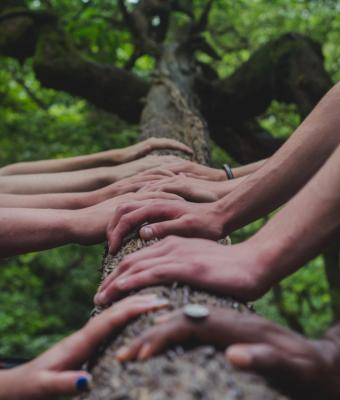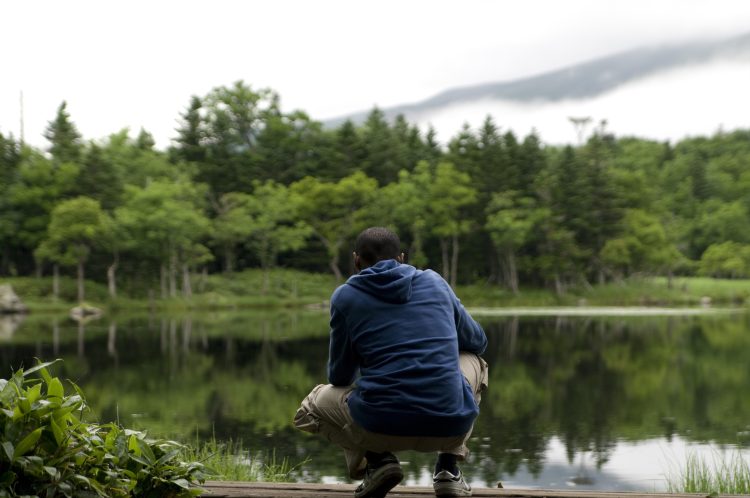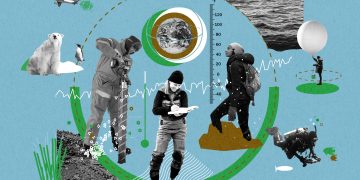The rain begins before dawn.
Not a heavy storm, but a soft percussion on the roof tiles, as if the Earth is whispering to itself.
In the half-light of morning, the streets smell of wet soil.
For a brief moment, before engines start and screens light up, there is a fragile silence—an invitation to listen.
I have often wondered whether the distance between humans and the natural world is not measured in miles of deforestation or degrees of warming, but in the loss of our capacity to listen.
1. A Walk beside the Mangroves
In the estuary where the river meets the sea, mangroves spread their roots like patient fingers, holding the soil against the tug of tides.
Fishermen who have spent their lives in wooden boats speak of these roots with reverence: they break the waves, shelter the fish, and even in cyclones, they seem to hold the village together.
Years ago, the mangroves were cleared for shrimp farms and resorts. The shoreline retreated. The storms came closer. Only after loss did the community begin to plant them again.
Today, when you walk the muddy paths among the young saplings, you hear more than the hum of insects—you hear a memory being repaired.
It strikes me that harmony is often restorative, born not of untouched wilderness but of a human decision to mend what was once torn.
2. The Forgotten Meadow
In the city where I live, there used to be an empty lot behind a row of factories.
For decades it was treated as a dump. Broken bottles, rusted barrels, and weeds tangled under the summer sun.
One spring, a group of students began to clear the debris. They planted wildflowers: coneflowers, milkweed, black-eyed Susans.
By autumn, butterflies returned—monarchs with wings like stained glass.
Old factory workers, at first indifferent, started to bring water in buckets to help the plants through dry spells.
It was not a grand conservation project. There were no headlines.
But in the quiet persistence of neighbors, the meadow became a small parliament of species, reminding the city that life can negotiate even in forgotten corners.
3. Mountains Seen from a Train Window
On a winter journey across the highlands, I looked out of the train window and saw bare slopes dotted with the skeletons of pines.
A man seated beside me, a retired teacher, told me that the hills were once dense forests, cut down during years of civil conflict.
Now, he said, villagers were planting seedlings again. “We will not see the forest return in our lifetime,” he added, “but perhaps our grandchildren will.”
There was a calm dignity in his voice.
The idea that coexistence is not a project for the next election cycle but for the next century is humbling.
We often think of progress as speed; perhaps true progress is duration, the willingness to work for results we may never personally enjoy.
4. The Glacier’s Diary
Scientists say glaciers record time.
Each layer of ice holds tiny bubbles of air, traces of centuries past.
I stood once on the edge of a retreating glacier in Patagonia. The ice cracked like distant thunder. A meltwater stream carved a silver path across the rocks.
The guide, a young woman who had grown up nearby, said she remembered when the glacier’s tongue reached far into the valley where now only boulders lay.
We talk of glaciers as casualties of climate change, but standing there I felt as though we were losing a library—pages of history melting into the ocean.
To coexist with nature means not only protecting the living but also respecting the memory that landscapes hold.
5. The Orchard at Dusk
An old farmer once invited me to his orchard.
He grew pears and plums without chemical fertilizers, relying on compost and the instinct inherited from his father.
As dusk fell, we sat on a wooden bench watching bats flit among the branches.
He said, “I don’t think of myself as saving nature. I just think of this orchard as a place where I am a guest, not a master.”
In that sentence lay a quiet philosophy: the recognition that to live is to dwell as a guest on Earth, grateful for what we are given, careful not to overstay our welcome.
6. The Market of Plastic and Prayer
In a coastal town of Southeast Asia, I once wandered through a bustling market.
Vendors sold fish still glittering with seawater, alongside plastic trinkets that would soon find their way back to the ocean as waste.
Near the harbor, an old shrine overlooked the bay. Fisherfolk stopped to offer prayers before setting out to sea.
I wondered how long it had been since the prayer and the plastic had come to share the same space.
This juxtaposition captured our age: we kneel to bless the sea even as we poison it.
Coexistence is not merely a technical challenge but a cultural contradiction, demanding not only new tools but new stories about what we value.

7. A Tale of Shared Breath
In the depths of the Amazon, a scientist once told me that a single mature tree can support hundreds of species—birds, insects, fungi, mammals.
It is not just a tree; it is a village of life.
When such a tree falls, the loss is not measured only in carbon or board-feet of timber, but in the broken network of relationships.
I thought of the air we breathe—oxygen released by distant forests, by plankton in unseen oceans.
Every breath is a form of participation in a planetary conversation.
Harmony, then, is not an abstract treaty. It is a shared physiology.
8. Children by the River
I remember watching children in a rural school gather by a river as part of an environmental education program.
They dipped their hands into the water to observe tiny shrimp and dragonfly larvae.
They drew pictures of fish and birds on cardboard sheets.
One boy said, “The river is like a long playground.”
A girl added, “The river is also a teacher. It tells us when we are doing something wrong.”
Perhaps the future of coexistence depends less on sophisticated policies and more on whether the next generation grows up with empathy for other species.
9. The Ethics of Enough
At a conference on sustainability, I listened to economists debate carbon pricing, trade regulations, and technological breakthroughs.
In a quieter corner, a philosopher posed a simple question: “What if coexistence requires us to want less?”
It was an unsettling thought.
Much of our culture is built on the idea of wanting more—more wealth, more convenience, more choice.
But harmony may mean recognizing the sufficiency of enough.
To accept limits not as deprivation but as a form of respect.
10. A Winter Night’s Meditation
On a cold night in the countryside, I stepped outside to see the stars.
The air was still, the ground crisp with frost.
Somewhere in the distance, an owl called.
Looking up, I felt both tiny and connected—part of a vast system that stretches from soil microbes to galaxies.
It is said that the first philosophers in ancient times began by wondering at the sky.
Perhaps the future of our relationship with nature also begins with wonder—a sense of awe that precedes calculation.
11. Notes on Language
The words we use shape our imagination.
We speak of resources, as if forests and rivers exist merely to be consumed.
We call wild animals stocks or game, as if they were entries in an account book.
But what if we spoke instead of neighbors, kin, or companions?
Language, too, can be an instrument of coexistence or of alienation.
12. Letters Unsent
If one could write a letter to the Earth, what would it say?
Dear Earth,
We are sorry for our noise and haste.
We are grateful for the rivers and winds that have carried our boats and mills.
We hope to learn again how to listen.
Such a letter would not be a confession of guilt alone.
It would be a promise to be a better partner in the long story of life.
13. Toward a Gentle Future
There will be no single grand summit where humanity signs a final peace treaty with nature.
Coexistence will be an ongoing practice, a mosaic of choices—some in the halls of government, others in gardens, classrooms, villages, and markets.
The future may be uncertain, yet it is still unwritten.
The ink with which we write it is the daily interaction between human hands and the living world.
Perhaps the path forward is not paved in concrete highways or written in volumes of law but traced in the footsteps of people planting trees, cleaning rivers, tending to bees, sharing knowledge across cultures.
The rain that began before dawn has now ceased.
The air smells of wet leaves and distant blossoms.
I think again of the mangroves, the meadow, the orchard, the glacier, the children by the river.
Their stories weave together not into a conclusion but into a continuing invitation:
to live more gently, to remember that every breath is shared, to find in listening the first step toward belonging.

















































